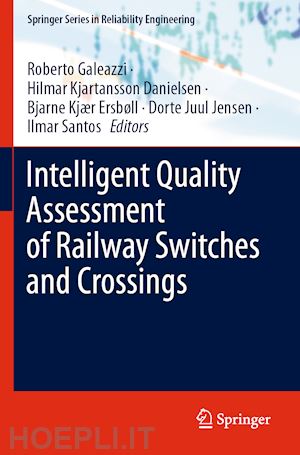
Questo prodotto usufruisce delle SPEDIZIONI GRATIS
selezionando l'opzione Corriere Veloce in fase di ordine.
Pagabile anche con Carta della cultura giovani e del merito, 18App Bonus Cultura e Carta del Docente
This book focuses on the latest scientific and technological advancements in the field of railway turnout engineering. It offers a holistic approach to the scientific investigation of the factors and mechanisms determining performance degradation of railway switches and crossings (S&Cs), and the consequent development of condition monitoring systems that will enable infrastructure managers to transition towards the implementation of predictive maintenance.
The book is divided into three distinct parts. Part I discusses the modelling of railway infrastructure, including switch and crossing systems, while Part II focuses on metallurgical characterization. This includes the microstructure of in-field loaded railway steel and an analysis of rail screw failures. In turn, the third and final part discusses condition monitoring and asset management.Given its scope, the book is of interest to both academics and industrial practitioners, helping them learn about the variouschallenges characterizing this engineering domain and the latest solutions to properly address them.
Roberto Galeazzi is an Associate Professor of Control Theory and Technology. His main areas of research are fault diagnosis and failure prognosis for safety-critical systems. He researches methods and tools for the design of condition monitoring systems that can operate in real industrial contexts. His research displays a high level of multidisciplinarity, drawing from the scientific areas of system dynamics, estimation theory, signal processing, system identification, probabilistic learning, and change detection theory. The validity of his scientific approach has already been demonstrated for the operational safety of merchant and offshore vessels, as well as high-speed rotating machines.
Hilmar K. Danielsen is a Senior Researcher with 15 years of experience in metallurgical research and the development of steels, working in close cooperation with international research groups as well as industry on an international level. His main research area is metallic components and structures for wind turbines and combines metallurgical characterization and mechanical testing, primarily for rolling contact fatigue in wind turbine bearing steels and rails. He has also been active in other fields, e.g. alloy development, high-temperature creep-resistant steels, and thermodynamic and kinetic modelling.
Bjarne K. Ersbøll is a Professor of Statistics and Data Analysis. He has considerable experience in the application of these disciplines in industrial and medical projects. His research is largely inspired by finding solutions to real-world problems in industry – and often in collaboration with industry. In addition to his educational duties, he provides research-based consultancy on applied statistics and data analysis.
Dorte Juul Jensen is a Professor of Materials Science and Advanced Characterization. Her main areas of research include plastic deformation and annealing of metallic materials; X-ray diffraction, electron microscopy, and neutron scattering characterization of materials; development of new characterization techniques, e.g. 4-dimensional microstructural mapping; and advanced manufacturing of metallic materials. Further, her work ranges from applied research (e.g. faults in rails, advanced steels for automotive, and aluminium for packaging) to basic science (presently financed via an ERC Advanced Grant on metal microstructures in 4 dimensions).
Ilmar F. Santos is a Professor of Mechanical Engineering at the Technical University of Denmark. His main areas of research include dynamics and control of machines and structures, high-fidelity mathematical modelling based on multiphysics (virtual twins), contact mechanics, and tribology. His work ranges from applied research – focusing on the degradation of rail components due to the dynamic interaction with passing trains and aided by high-fidelity simulation models – to basic science on multibody dynamics, vibration monitoring and analysis, and contact mechanics.











Il sito utilizza cookie ed altri strumenti di tracciamento che raccolgono informazioni dal dispositivo dell’utente. Oltre ai cookie tecnici ed analitici aggregati, strettamente necessari per il funzionamento di questo sito web, previo consenso dell’utente possono essere installati cookie di profilazione e marketing e cookie dei social media. Cliccando su “Accetto tutti i cookie” saranno attivate tutte le categorie di cookie. Per accettare solo deterninate categorie di cookie, cliccare invece su “Impostazioni cookie”. Chiudendo il banner o continuando a navigare saranno installati solo cookie tecnici. Per maggiori dettagli, consultare la Cookie Policy.